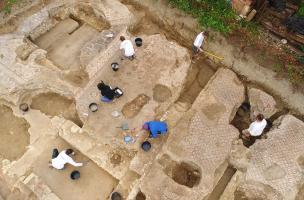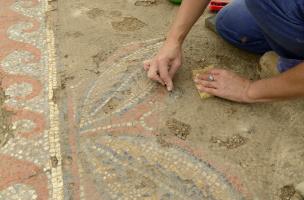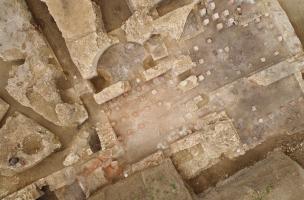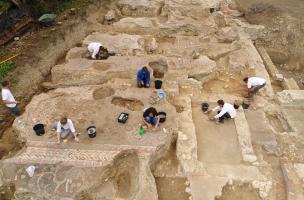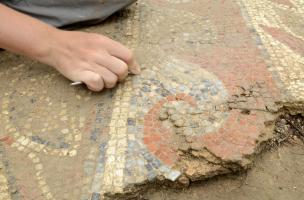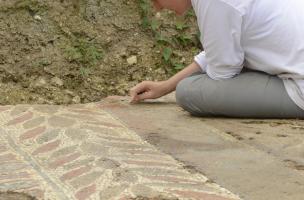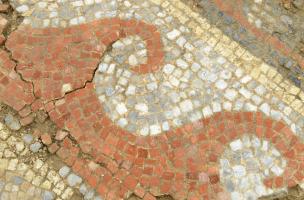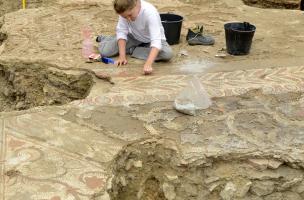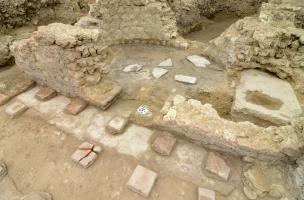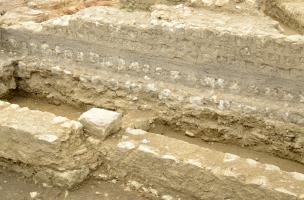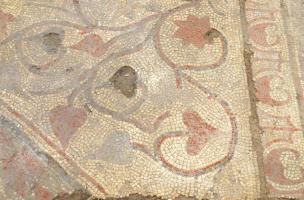You are here
A vast Antique aristocratic residence discovered in Auch
Elimberris is situated on the right bank of the Gers, today just below the modern urban center. Across 800 m², the excavation revealed the first human settlements dated to the second half of the 1st century BC.
In Auch, an Inrap team is currently excavating a vast Antique aristocratic residence. This excavation, curated by the State (Drac Occitanie), is located less than one hundred meters from the forum of the Antique city of Elimberris. This new archaeological site is very important since much of the Gallo-Roman past of Auch remains be discovered. Until now, it had been perceived only through one early excavation and around ten diagnostic operations.
Ancient Auch
Elimberris is situated on the right bank of the Gers, today just below the modern urban center. Across 800 m², the excavation revealed the first human settlements dated to the second half of the 1st century BC. However, the first tangible signs of a clear urbanization do not appear until the beginning of the 1st century AD. The expansion of the city began during this period, with its urban layout being structured by a road system oriented, as to be expected, according to the cardinal points. The presence of the forum and high-quality private residences was observed during the diagnostic operations and archaeological test excavations. During the Late Roman Empire, the city seems to have been prosperous, as shown by the presence of luxurious residences with hot baths and mosaic floors. It is one of these that is now coming to light…
A domus and its mosaics
Just after 320-330 AD, this domus was equipped with a central heating system. The remains thus far uncovered are contained within a single building, 28 m long and 10 m wide. At least three rooms with underfloor heating (which archaeologists call radiant hypocausts) are decorated with polychrome mosaics. Two of them have geometric motifs composed of octagons and squares for one, and “cockades” for the other. The third, larger, one is composed of complex geometric and floral motifs. Mosaics also decorated the walls, as is shown by the fragments of molten glass tesserae, in bluish black, green or red, found in the ancient gravels on top of the floors.
These mosaics are clearly of the “Aquitaine style”, which developed at the end of Antiquity in south-eastern Gaul. Well known in some large rural villae, these pavements are less frequent in urban contexts, though they have been found in Bordeaux, Eauze, and now Auch.
During its history, the domus underwent two major architectural renewals, shown by a later mosaic that was created on top of another from an earlier period of the residence.
This aristocratic residence was abandoned between the end of the 4th and beginning of the 5th century. Its building materials were then systematically pillaged for use elsewhere: stones were taken from the walls, marble paving was torn up from the floors, and heating tiles were pulled out, thus amputating part of the mosaics.
Starting on July 17, the mosaics with be consolidated and deposited for restoration. Protected from further damage, they can then be presented to the public. A report will be written by the archaeologists, the most significant results will be published, and a collaborative research project concerning Auch will be developed.
For now, with the mosaics removed, the excavation can continue, so that we may discover the Auchs of the 1st and 2nd centuries AD…
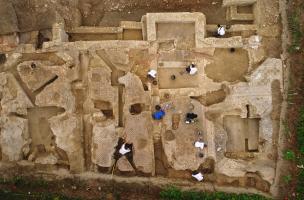
Vue d'ensemble du dernier état d'une domus en cours de fouille (seconde moitié du IVe siècle), Auch (Gers) 2017.
© Jean-Louis Bellurget, Inrap
Vincent Charpentier
Director
Inrap, media partnerships and relations
01 40 08 80 16 – vincent.charpentier [at] inrap.fr
Mathilde Ponzio
Cultural development and communication
Inrap, direction interrégionale Grand Sud-Ouest
05 57 59 21 05 – mathilde.ponzio [at] inrap.fr


